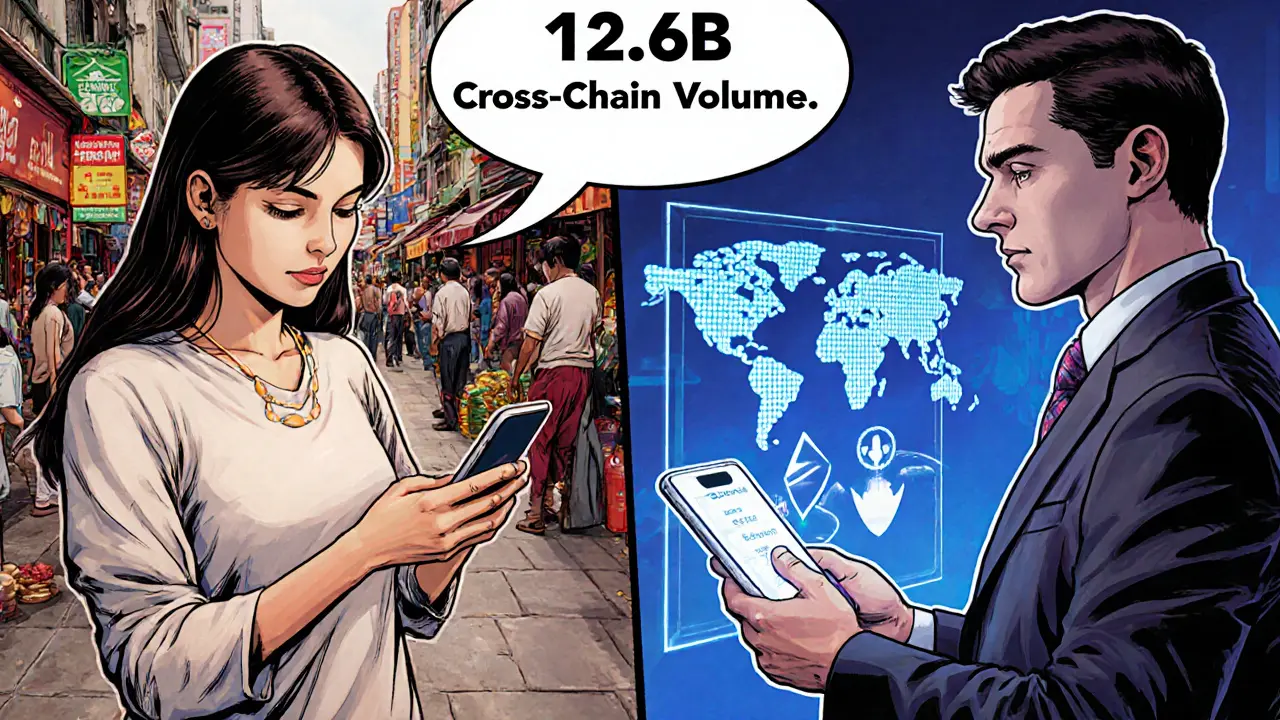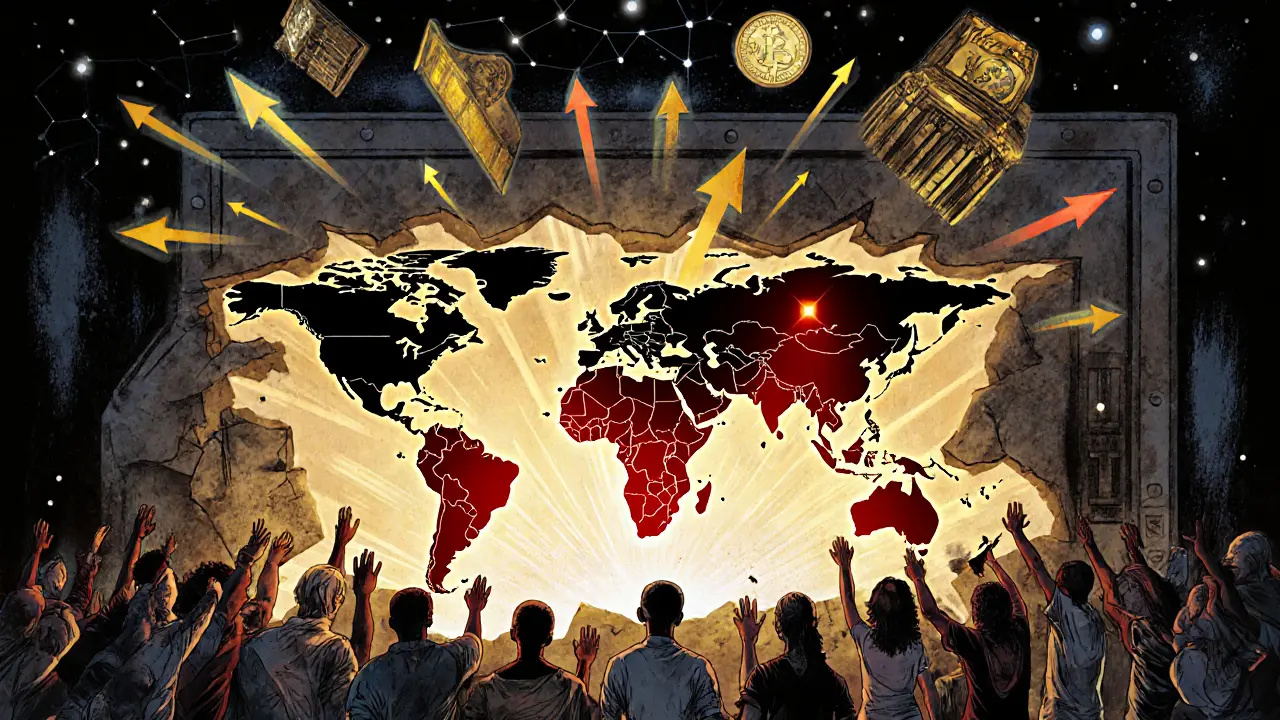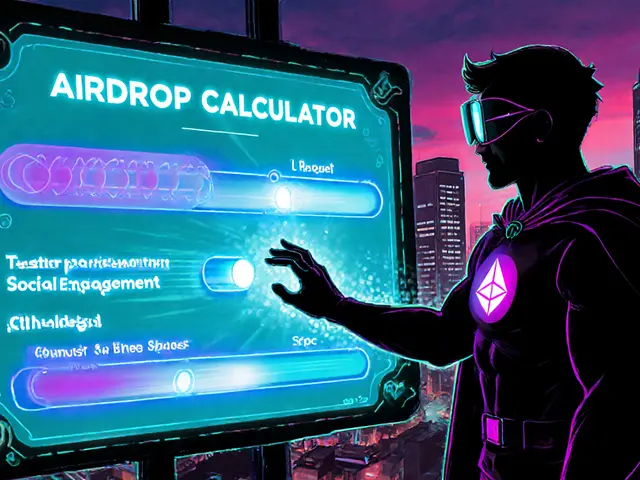- Home
- Blockchain
- DeFi Growth Statistics and Adoption: Market Trends, TVL, and Regional Adoption in 2025

DeFi Growth Statistics and Adoption: Market Trends, TVL, and Regional Adoption in 2025
DeFi TVL Growth Estimator
Current DeFi TVL Data
$123.6 billion in Total Value Locked (TVL) as of early 2025
41% growth from previous year
Projected $1.56 trillion by 2034 (50x increase)
Estimate Your Projection
Projection Results
Starting Value
Growth Rate
Time Period
By 2025, DeFi isn't just a buzzword anymore-it's a functioning financial layer on top of blockchain networks, moving billions in value every day without banks, brokers, or paperwork. If you're wondering whether this movement is real or just hype, the numbers don't lie. Total Value Locked (TVL) across all DeFi protocols hit $123.6 billion in early 2025, up 41% from the year before. That’s not a minor uptick. That’s a system gaining real traction, and it’s happening right now.
How Big Is the DeFi Market Really?
There’s no single answer to how big DeFi is because different research firms measure it differently. Some count only protocol revenues. Others include all assets locked in smart contracts. Some include stablecoins; others don’t. That’s why you’ll see wildly different numbers.CoinLaw says the market was worth $30.07 billion in 2024. Grand View Research says $20.48 billion. NextMSC puts it at $29.05 billion. Precedence Research, the most aggressive, estimates $32.36 billion for 2025. Even Statista, known for conservative estimates, expects $14.6 billion by 2026.
But here’s what matters: even the lowest projections show growth. The highest? Precedence Research predicts DeFi could hit $1.56 trillion by 2034. That’s a 50x increase from 2025 levels. Most analysts agree on one thing: growth is strong, even if the exact numbers vary.
Why the gap? It comes down to what’s being counted. If you include every dollar locked in lending, staking, or trading-regardless of whether it’s real money or just crypto moving around-you get a bigger number. If you only count assets that have real-world backing or are used for actual payments, the number shrinks. The truth is probably somewhere in the middle. But the trend is clear: more people are putting more money into DeFi every quarter.
Total Value Locked: The Real Measure of Trust
TVL isn’t just a metric-it’s a vote of confidence. When users lock up $123.6 billion in DeFi protocols, they’re saying: “I trust this code more than a bank.” That’s huge.Top protocols like Aave, Compound, and Uniswap all rely on stablecoins as collateral. Why? Because they’re stable. You can’t borrow $10,000 worth of ETH if ETH drops 30% overnight and you get liquidated. But you can borrow against USDC or DAI-tokens pegged to the U.S. dollar.
As of June 2025, $146 billion in stablecoins were circulating inside DeFi apps. USDC appears in 92% of the top lending and exchange platforms. DAI, the decentralized stablecoin backed by crypto collateral, has an $8.4 billion supply, and over 71% of that is used directly in DeFi strategies. Even Tether (USDT), which dominates on BNB Chain and Tron, only has 58% of its total supply active in DeFi-meaning a lot of it is still sitting on exchanges or used for trading, not lending.
New players are rising fast. Ethena’s USDe, a crypto-backed stablecoin built on Ethereum, hit $1.9 billion in DeFi integration within six months of launch. That’s faster than most traditional fintech products take to reach $1 billion. Meanwhile, decentralized-only stablecoins like sUSD and LUSD are holding steady at a combined $2.7 billion, showing there’s real demand for non-corporate, non-centralized money.
Stablecoins Are the Engine-But Not the Only Fuel
Stablecoins are the backbone of DeFi, but they’re not the whole story. Synthetic assets-tokens that mirror the price of real-world things like gold, stocks, or real estate-are now worth $3.2 billion in DeFi. That’s not just speculation. That’s people using blockchain to trade assets they couldn’t access before.For example, someone in Nigeria can now buy a token representing a fraction of a Manhattan apartment without ever stepping foot in the U.S. Or a farmer in Kenya can hedge against coffee price swings using synthetic commodities. These aren’t theoretical use cases-they’re live, active, and growing.
And the bridges connecting these systems? Cross-chain stablecoin transfers processed over $12.6 billion in the first half of 2025 alone. That means users aren’t just stuck on Ethereum. They’re moving money between Solana, Arbitrum, Base, and Polygon without needing a centralized exchange. That’s the real power of DeFi: permissionless, global, and open.

Where Is DeFi Growing Fastest?
North America still leads in market size. The U.S. DeFi market was valued at $5.84 billion in 2024, and it’s expected to hit $441 billion by 2034. That’s not because Americans are crypto fanatics-it’s because of institutional adoption. Hedge funds, asset managers, and even some banks are quietly building DeFi exposure through regulated custodians and tokenized securities.But the fastest growth? Asia Pacific. Countries like India, Indonesia, and the Philippines are seeing explosive adoption. Why? Mobile-first users. High smartphone penetration. A young population that doesn’t trust banks but trusts apps. Local startups are building DeFi platforms that look and feel like TikTok or Grab-simple, fast, and intuitive. One app in Indonesia lets users earn yield on their stablecoins with one tap. No KYC. No forms. Just a wallet and a phone.
Europe is catching up fast. Regulatory clarity in the EU-especially around MiCA (Markets in Crypto-Assets Regulation)-has given institutions the confidence to enter. German and Swiss banks are now testing tokenized bonds on public blockchains. French fintechs are integrating DeFi yield into savings apps.
Meanwhile, in Latin America and Africa, DeFi is filling gaps left by broken banking systems. In Argentina, where inflation hit 280% in 2024, people are locking pesos into DeFi protocols to earn 8-12% annual yield in USDC. In Nigeria, where 40% of adults are unbanked, DeFi apps are becoming the default way to save and send money.
What’s Driving This Growth?
It’s not just one thing. It’s a mix of tech, regulation, and real need.Layer-2 solutions like Arbitrum and Optimism slashed transaction fees by 90%. Before, a simple swap cost $50. Now it’s $0.10. That made DeFi usable for everyday people, not just speculators.
Regulatory clarity in the U.S. and EU added 1.8% to projected growth. When you know the rules, you can build. When you don’t, you wait. Now, firms are hiring compliance officers specifically for DeFi.
AI-powered robo-advisors are now automating yield strategies. Instead of manually moving funds between protocols to chase the best APY, users can set up a bot that does it for them. These tools are growing at 0.9% per year in projected CAGR-small, but significant.
Real-world asset tokenization is picking up pace. Tokenized real estate, treasury bills, and even carbon credits are entering DeFi. This isn’t crypto replacing finance-it’s crypto extending it.

Why Isn’t Everyone Using DeFi Yet?
Because it’s still risky. Smart contract bugs have cost users over $3 billion since 2020. Even big names like Curve and Yearn have been hacked. Users aren’t protected by FDIC insurance. If you lose your private key, your money is gone. No customer service. No chargebacks.Most people don’t understand how to use a wallet. They don’t know what gas fees are. They get scared by the jargon. And when a news headline says “DeFi platform collapses,” they remember that-not the 99% that ran smoothly.
That’s why adoption is still slow outside crypto-native circles. But that’s changing. Apps like Argent and Safe are building wallet interfaces that look like Venmo. Educational platforms are making short videos explaining DeFi in plain language. Schools in Singapore and Canada are teaching blockchain finance in high school economics classes.
The Road Ahead
By 2030, DeFi will likely be a normal part of the financial landscape-not a fringe experiment. You’ll see it in your retirement app. In your payroll system. In your grocery store’s loyalty program.Some will still prefer banks. That’s fine. But for the 1.4 billion unbanked adults worldwide, DeFi isn’t an alternative-it’s the only option. And that’s where the real growth is.
The numbers show it. The technology enables it. The people are ready for it. DeFi isn’t coming. It’s already here.
What is DeFi and how does it work?
DeFi, or Decentralized Finance, is a system of financial services built on blockchain networks-mostly Ethereum-that operate without banks or middlemen. Instead of a bank approving your loan, a smart contract automatically does it based on rules written in code. You lend, borrow, trade, or earn interest by interacting with these contracts using a crypto wallet. Everything is transparent, open to anyone with an internet connection, and runs on public blockchains.
Is DeFi safe to use?
DeFi has risks. Smart contracts can have bugs, and if exploited, your money can be stolen. There’s no FDIC insurance. If you send funds to the wrong address or lose your private key, there’s no way to recover them. That said, the most popular protocols like Aave and Uniswap have been audited multiple times and have run without major issues for years. For beginners, sticking to well-established platforms with high TVL and clear documentation reduces risk significantly.
Why are stablecoins so important in DeFi?
Stablecoins like USDC and DAI are pegged to the U.S. dollar, so their value doesn’t swing like Bitcoin or Ethereum. That makes them ideal for lending, borrowing, and earning interest without the risk of sudden price drops. Over $146 billion in stablecoins were used in DeFi protocols in mid-2025. Without them, most DeFi apps would be too volatile for everyday use.
What’s the difference between DeFi and traditional banking?
Traditional banking relies on centralized institutions-banks, regulators, clearinghouses-that control access, set rules, and charge fees. DeFi removes those middlemen. Anyone with a wallet can lend, borrow, or trade without permission. Fees are lower, access is global, and transactions are faster. But you’re responsible for your own security. No customer service line to call if something goes wrong.
Which countries are leading in DeFi adoption?
North America, especially the U.S., leads in market size due to institutional investment and tech infrastructure. But Asia Pacific is growing the fastest, driven by mobile users in India, Indonesia, and the Philippines who use DeFi for savings and remittances. Europe is catching up thanks to clear regulations like MiCA. In Latin America and Africa, DeFi is replacing broken banking systems for millions who are unbanked or underbanked.
Will DeFi replace banks?
It won’t replace banks entirely-but it will change them. Banks are already partnering with DeFi protocols to offer crypto-backed loans or tokenized assets. The future isn’t banks vs. DeFi. It’s banks using DeFi to become faster, cheaper, and more inclusive. For people without access to traditional finance, DeFi isn’t a replacement-it’s the first door.
Cormac Riverton
I'm a blockchain analyst and private investor specializing in cryptocurrencies and equity markets. I research tokenomics, on-chain data, and market microstructure, and advise startups on exchange listings. I also write practical explainers and strategy notes for retail traders and fund teams. My work blends quantitative analysis with clear storytelling to make complex systems understandable.
About
DEX Maniac is your hub for blockchain knowledge, cryptocurrencies, and global markets. Explore guides on crypto coins, DeFi, and decentralized exchanges with clear, actionable insights. Compare crypto exchanges, track airdrop opportunities, and follow timely market analysis across crypto and stocks. Stay informed with curated news, tools, and insights for smarter decisions.


